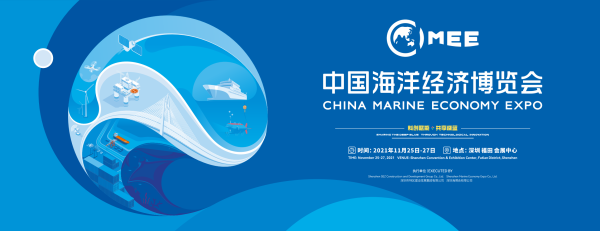 Signe Brudeset Norwegian Ambassador to China
Signe Brudeset Norwegian Ambassador to ChinaTechnological innovation and business evolution shall be key drivers of the sustainable development of the world.
A series of dialogues of "Talk with Blueconomy" are initiated by China Marine Economic Expo (hereinafter referred to as the CMEE). It invites high-level guests from government, commerce, science and technology, economy, ideology, culture and many other fields to discuss important issues affecting the global blue future, aiming at promoting cutting-edge exchanges between science and technology and commerce, building a sustainable development ecology of the global commercial society and advancing towards a new global blue future.
The CMEE is held once a year in Shenzhen. As the only national marine economic exhibition in China, it serves as an important economic and trade platform to promote the high-quality development of marine economy, promote international cooperation in blue economy and jointly build “the 21st Century Maritime Silk Road.”

Norway, located in the western part of Scandinavia. This country in northern Europe has a long and narrow territory and a long and winding coastline, dotted with coastal islands. Norway's prosperous marine economy benefits from its unique geographical location. As a traditional marine economic power, Norway's rich marine resources have given great impetus to its economic development. According to a study by NME (Norwegian Maritime Exporters Association), Norway's marine industry supplies 5% of the world's ship equipment, and 70% of its ship equipment production is used for export. In addition, Norway not only has a mature and advanced marine industry, but also has made great contributions to the sustainable development of marine economy.
Ms. Signe Brudeset, Norwegian Ambassador to China said, China and Norway have achieved close cooperation and broad development prospects in many fields, especially in climate, energy, environment, maritime affairs and education. In her opinion, under the background of global development of sustainable marine economy, promoting further cooperation between the two countries in marine environmental protection and sustainable development will contribute to the sound development of marine economy of the two countries.
Q1: As a traditional marine economic power, can you tell us something about Norway's experience in developing marine economy?
Signe Brudeset: Norway's ocean area is about six times the land area, so marine economy constitutes an extremely important part of Norway's economic body. I think Norway's development of marine economy has the following two characteristics.
First, a sustainable Marine economy is vigorously developed in the country. In 2017, the Norwegian government issued the White Paper on Ocean, and based on this, formulated the ocean policy. At present, Norway is striving to promote the realization of sustainable economy in aquaculture, fisheries, offshore wind power and submarine facilities, and green shipping. For example, Equinor started the commercial operation of the world's first floating offshore wind farm in 2017. This offshore floating wind power technology can reduce the consumption of non-renewable fuels such as oil and reduce unnecessary pollution. With the progress of technology, the cost of floating wind power will be further reduced, so the company will become more competitive in the international market.
Second, the government has always given great support to the marine economy. Sustainable development model is a good path of Norwegian marine economic development, and government support is the policy basis of Norwegian marine economic development. Because Norway is a small open economy, the Norwegian government believes that the marine economy industry has high added value, and if this industry is developed, it will definitely promote the economic development of a small country like Norway. What’s more, Norway's marine economic industry has a long history and a wide range of customer groups, and the government will certainly give certain policy inclination to the marine economic industry with more obvious competitive advantages.
Q2: What measures has Norway taken to promote sustainable marine economic development?
Signe Brudeset: The Norwegian government strongly supports the implementation plan of the United Nations Decade of Marine Science for Sustainable Development (2021-2030).
Norway is a traditional marine economic power with abundant marine resources. More importantly, Norway is making every effort to promote the development of global sustainable marine industry. It has accumulated a lot of valuable experience especially in dealing with marine pollution, innovating mariculture, marine low-carbon sustainable development technology, green shipping and so on.
In order to better solve the problem of marine pollution, the Norwegian government has established a beverage bottle recycling system. The government stipulates that Norwegian consumers will get a certain reward for putting discarded beverage bottles into designated recycling points; On the other hand, all plastic manufacturers and enterprises engaged in import business are required to pay corresponding environmental taxes, and this fee is not a small amount. Therefore, if the company recycles a lot of plastic bottles, it can pay less or no tax. This method can not only develop circular economy and reduce plastic waste flowing into the ocean, but also stimulate individual participation and awareness of environmental protection.
In terms of green shipping, the Norwegian government has launched a green shipping plan. The plan was jointly launched by the government and enterprises in 2015, aiming at consolidating Norway's status as a major shipping country and seeking widely applicable solutions for the green development of the shipping industry. Norway plans to deploy electric ferries for its coastal transportation, and in the next few years, 80% of Norwegian coastal ferries will be powered by batteries. In addition, Norwegian ships also plan to use hydrogen fuel cells and hybrid power to push ships to use clean energy and achieve low emissions in the ship field.
Q3:What‘s your opinion of the sustainable development strategy of China's marine economy, and do you have any suggestions in this regard?
Signe Brudeset: Actually, the sustainable development of marine economy is the general trend of global marine development in the future, and China has keenly discovered this development direction and made a strategic choice in time, which is a visionary approach.
From a policy perspective, some of Norway's mature practices and policy mechanisms can be learned from by China. For example, for the traditional power generation industry, carbon and nitrogen oxide emission taxes can be levied, enterprises can be encouraged to save energy and reduce emissions, and special taxes can be used to solve actual marine environmental problems; For the aquaculture industry, policy support can be provided through the extensive application of artificial culture technology to reduce excessive marine fishing.
From a technical point of view, China can also learn and introduce Norway's advanced shipping technology. For example, the most popular LNG-fueled ship in Norway has been in use since 2000. In my opinion, this technology and concept can also provide reference for the development of shipping field in China, and accumulate experience through pilot projects, and then turn the experience into normative policies.
Q4: How can we better proceed the exchanges and cooperation between China and Norway?
Signe Brudeset: In my opinion, it can be carried out from the following two aspects.
First, Norway will continue to explore China's seafood market. Norway is the second largest seafood exporter in the world, and its marine and fish resource management and aquaculture industry are in a leading position in the world. According to the Norwegian seafood export data released by the Norwegian Seafood Bureau in 2020, although the grim market situation was rather grim in 2020, Norway's seafood still achieved an high export volume is of 2.7 million tons, which is equivalent to providing nearly 37 million seafood meals to the world every day, with a export value of 105.7 billion Norwegian kroner (equivalent to 79.5 billion yuan), thus setting a second record in history. Affected by COVID-19 in 2020, the seafood trade between Norway and China showed an overall downward trend. However, in the past challenging year, Norwegian sea industry was still able to cope with the changes quickly, and achieved the second highest export volume to China in history. By 2030, the contribution of marine economy to global economic value added will double. Therefore, there are broad prospects for cooperation and market increment between China and Norway.
Second, the two countries will have more extensive exchanges and cooperation in the field of shipping manufacturing. As a particularly important shipbuilding country, China provides a large number of ships for the whole world. Among them, nearly 30% of Norwegian ships are made in China. Therefore, judging from this perspective, there is a solid foundation for cooperation in marine industrial manufacturing between two countries. On the other hand, Norway has accumulated abundant experience in marine industry and science and technology. In Norway, many companies can provide high-quality and high-level products, technologies and services, which can provide a powerful driving force for the development of China's marine manufacturing industry.
Media Contact
Company Name: China Marine Economy Expo (CMEE)
Contact Person: Media Relations
Email: Send Email
Phone: 0755-82512311
Country: China
Website: https://www.cimee.com.cn/en/